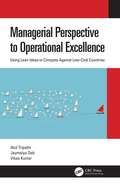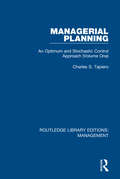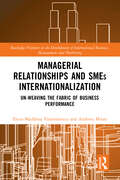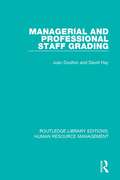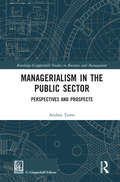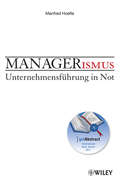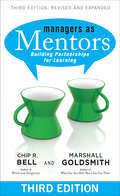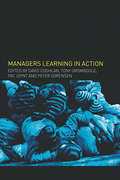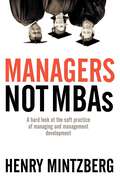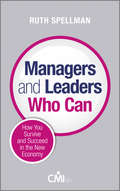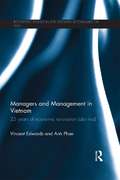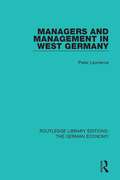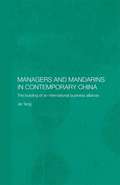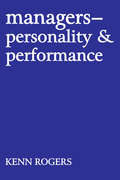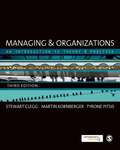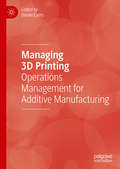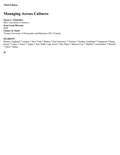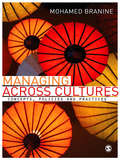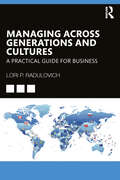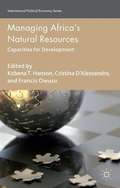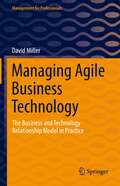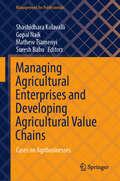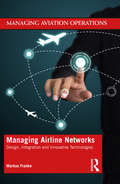- Table View
- List View
Managerial Perspective to Operational Excellence: Using Lean Ideas to Compete Against Low-Cost Countries
by Vikas Kumar Atul Tripathi Jaymalya DebIn the current age of manufacturing revival in the U.S. and other developed countries, companies are looking for ways to maintain or gain advantage over competitors from low-cost countries. This book presents a firsthand account of actual projects in three different industries to help leaders and middle managers structure their own turnaround or improvement projects. The book uses a case-based approach for Lean implementation and presents a summary of lessons learned and insights on change management. It includes examples of Robotic Process Automation concepts used in manufacturing and offers several examples of analytical tools used to solve operations management problems. The first-person, story-based approach makes this book an engaging read for operations leaders and middle management in the areas of quality management, engineering management, business management, and manufacturing, as well as postgraduate students.
Managerial Planning: An Optimum and Stochastic Control Approach (Volume 1) (Routledge Library Editions: Management #49)
by Charles S. TapieroOriginally published in 1977. Management is a dynamic process reflected in three essential functions: management of time, change and people. The book provides a bridging gap between quantitative theories imbedded in the systems approach and managerial decision-making over time and under risk. The conventional wisdom that management is a dynamic process is rendered operational. This title will be of interest to students of business studies and management.
Managerial Planning: An Optimum and Stochastic Control Approach (Volume 2) (Routledge Library Editions: Management #49)
by Charles S. TapieroOriginally published in 1977. Management is a dynamic process reflected in three essential functions: management of time, change and people. The book provides a bridging gap between quantitative theories imbedded in the systems approach and managerial decision-making over time and under risk. The conventional wisdom that management is a dynamic process is rendered operational. This title will be of interest to students of business studies and management.
Managerial Problem Solving: A Congruence Approach
by Michael L. Tushman Charles A. O'ReillyUnless managers and their teams clearly understand the roots of today's barriers to achieving strategic opportunities, their attempts to solve these problems are likely to be ineffective. In this chapter, the authors introduce a congruence-based approach to problem solving that will drive today's success.
Managerial Relationships and SMEs Internationalization: Un-weaving the Fabric of Business Performance (Routledge Frontiers in the Development of International Business, Management and Marketing)
by Elena-Mădălina Vătămănescu Andreea MitanAs the "backbone of the economy," small- and medium-sized enterprises (SMEs) are key players in the dynamics of local, regional, and global markets, and are often obliged to provide timely responses to the increasingly fierce cross-border competition. However, SMEs internationalisation has temporarily been subject to a wait-and-see policy under the numerous uncertainties and global systemic disruptions. Despite the "new normal" brought about by the COVID-19 pandemic, recent studies show that the future still holds the potential to avail business performance opportunities to SMEs, and the hopes of managers for the years to come are reasonably high. Adopting a relationship-centric perspective, the book proposes a deeper analysis of the role of managerial relationship building and development and SMEs internationalization. In the networked economy, relationships are the invisible threads of the highly interconnected world. Either we call them connections, ties, bonds, or links, they are present everywhere marking the very essence of our lives, therefore claiming for wide consideration. Giving way to a stepwise screening of relationships and SMEs internationalization, the book is simultaneously addressed to scholars from different fields of study (i.e., international management, international business, international relationship marketing, etc.) and worldwide decision-makers (i.e., entrepreneurs and managers) interested in conducting smart business abroad.
Managerial and Professional Staff Grading (Routledge Library Editions: Human Resource Management)
by David Hay Joan DoultonThis title, first published in 1962, explains a system of job evaluation suitable for managerial and professional posts, and calls for a radical rethinking of the essential requirements for senior jobs. With a focus on the British Broadcasting Company as well as other organisations, the authors examine commercial and industrial concerns in regards to their workforce and staff diversity. This title will be of interest to students of business studies.
Managerialism in the Public Sector: Perspectives and Prospects (Routledge-Giappichelli Studies in Business and Management)
by Andrea TomoThe purpose of this book is to offer insights into the complex and often unclear context of public sector management, providing a new theoretical and practical approach to the analysis and interpretation of these issues. The book is grounded in the awareness that the public sector has too often shown inefficiencies, despite the expensive measures taken, and from manifold perspectives such as the economic, social, organizational, and institutional ones, among others. It acknowledges the lack of behavioral, cultural, and context-oriented research in the field, thus proposing to innovate the debate and to expand the current understanding of which organizational features characterize modern public administrations, what factors influence the predominance of different models, with a special focus on the Italian setting, benefiting from a wholly comprehensive innovative methodological approach. The findings offer key implications for theory, practice, and policy-making, contending the importance of holistic approaches to the debate and abandoning pre-constituted schemes to put forth the relevance of behavioral models. It offers a key message: contextual-specific and cultural factors influencing individual behaviors are important and should better influence policy-making processes, towards "glocalization" in order to improve quality.
Managerismus: Unternehmensführung in Not
by Manfred Hoefle Hoefle ManfredThe term "managerism" coined by the author describes the form commonly found today of how companies are led, how added value is used and how people and values are treated. Advised by external consultants and stimulated by financial analysts, many managers have adopted a certain distance to their employees, who are now generally known as "FTEs", "headcount", or "human capital". Only recently have we been experiencing a lack of solidarity among company sites or divisions, a decrease in social responsibility and a loss of values. This development first seen in Germany in the 1990ers first culminated in the Internet-hype at the turn of the millennium and again during the recent bank crisis; it recurs at ever diminishing intervals. Manfred Hoefle describes the phenomenon of managerism as a generic defect among the management of predominantly listed companies. Mainly it is a deformation of management, as observed and taught by Peter Drucker. Or to put in another way: It is Gresham's Law: Bad behavior expels good behavior, because it is supposedly more successful. The reasons for this are: - penetrating capital markets, - the drifting apart of nominal and real economics, - intensified competition, - the systemic results of large-scale organization, - the basic constitution of humans or "organization men", and - the effects of news- and story-triggered media, arrogant consultants and interventionist politicians. Particular facets of managerism are illustrated in the manner of warnings, such as mercenaries in management, and the role of the consultant as "shaping fashions", etc. The book names and describes the deformation in concrete terms, while at the same time showing ways to escape and help.
Managers As Mentors: Building Partnerships for Learning
by Marshall Goldsmith Chip R BellThe updated third edition of &“the essential handbook for all those who are trusted advisors to aspiring leaders&” (Jim Kouzes, coauthor of The Leadership Challenge). This latest edition of the classic Managers as Mentors is a rapid-fire read that guides leaders in helping associates grow in today&’s tumultuous organizations. Thoroughly revised throughout with twelve new chapters, this edition places increased emphasis on the mentor acting as a learning catalyst with the protégé rather than simply handing down knowledge. As with previous editions, a fictional case study of a mentor-protégé relationship runs through the book. But now this is augmented with interviews with six top US CEOs. New chapters cover topics such as the role of mentoring in spurring innovation and mentoring a diverse and dispersed workforce accustomed to interacting digitally. Also new to this edition is the Mentor&’s Toolkit, six resources to help in developing the mentor-protégé relationship. This hands-on guide teaches leaders to be the kind of confident coaches integral to learning organizations. &“Tightly written . . . helpful techniques.&” —Scientific American &“This book will help you become the mentor you always wanted and honor the terrific ones you had.&” —Mark Goulston, bestselling author of Just Listen
Managers Learning in Action: Management Learning, Research And Education / Edited By David Coghlan ... [et Al. ]
by David Coghlan Tony Dromgoole Pat Joynt Peter SorensenRather than offering either a purely practical or theoretical context, this text is written by a team of managers and academics, combining theory and practice to create a holistic, and above all realistic, exploration of learning at work, including real life examples of management challenges. Whether rescuing an ailing organization or managing inter-organization relations, managing change or managing human resources, many of today's crucial management challenges are addressed. Covering a range of sectors, the organizations studied include those in: hi-tech manufacturing engineering telecommunications healthcare transport government agencies. Contributors are drawn from three well-established academic programmes: the Irish Management Institute/ University of Dublin Masters in Management Practice; the US Benedictine University PhD in Organizational Development and the Henley Management College DBA, and the volume is edited by the academic directors of these programmes. By offering these managers' own reflections on their experiences in the context of relevant management theory, this text provides an important and innovative contribution for those studying organizations as well as for those managers who are currently learning and developing at work.
Managers Not MBAs: A Hard Look at the Soft Practice of Managing and Management Development
by Henry MintzbergIn this sweeping critique of how managers are educated and how, as a consequence, management is practiced, Henry Mintzberg offers thoughtful and controversial ideas for reforming both."The MBA trains the wrong people in the wrong ways with the wrong consequences," Mintzberg writes. "Using the classroom to help develop people already practicing management is a fine idea, but pretending to create managers out of people who have never managed is a sham."Leaders cannot be created in a classroom. They arise in context. But people who already practice management can significantly improve their effectiveness given the opportunity to learn thoughtfully from their own experience. Mintzberg calls for a more engaging approach to managing and a more reflective approach to management education. He also outlines how business schools can become true schools of management.
Managers and Leaders Who Can
by Ruth SpellmanFor a successful world economic system we need some fundamental changes that respond to the changing nature and expectations of society. Capitalism has to become more robust, more acceptable and more sustainable.Managers and Leaders Who Can provides a vision and road-map for making sense of the new world we live in as it affects management and leadership. Looking at the new economic and social circumstances of the post-recession world and examining the implications holistically for management and leadership, for governments, employers and individuals alike, this book provides practical guidance and illustrations on how to take forward the development challenge on a national, organisational and individual level.Praise for Managers and Leaders Who Can:"Ruth Spellman's book is a timely and long awaited outstanding addition to the management literature. This is a 'must read' for anybody in a leadership or managerial role."Prof. Cary L. Cooper, CBE, Distinguished Professor of Organisational Psychology and Health at Lancaster University Management School"Ruth Spellman has provided the thought platform from which a younger generation of aspiring leaders and managers can transform the nature of their profession. I urge you to read this and be creative!"Des Benjamin, CEO Simplyhealth"In times of unprecedented change, Managers and Leaders Who Can equips managers with tangible tools and case studies to develop their own and their organisations' capabilities. Spellman offers superb, practical and up-to-date insight into what employees want, what managers need and what all business leaders have to focus on to develop competitive advantage in turbulent times."Christina Ioannidis, Founder and CEO, Aquitude; author of Your Loss: How to Win Back your Female Talent"Ruth is absolutely right to identify and describe how leadership has to adapt to a totally new business environment. The advice and thoughts in this book will be valuable to all leaders in the public and private sectors."Miles Templeman, DG, IOD"Chief Executives in the third sector are facing enormous challenges in the world they operate in. ACEVO members look to us for guidance in these difficult times and this book will be essential and very valuable reading for them in supporting them to make the changes many will need to make."Stephen Bubb, CEO ACEVO
Managers and Management in Vietnam: 25 Years of Economic Renovation (Doi moi) (Routledge Studies in the Growth Economies of Asia)
by Vincent Edwards Anh PhanThis book presents a comprehensive overview of managers and management in Vietnam, based on extensive original research, including interviews with a large number of managers in Vietnam. It shows how management in Vietnam is best understood from the perspective of Vietnamese managers themselves, rather than in terms of Western or Asian models of management. It discusses the range of enterprises in the Vietnamese economy, which, until 1986, was dominated by large state-owned enterprises and Soviet-style central economic planning, and where there is now a much greater variety, with a mix of privatised state-owned enterprises, foreign-owned companies, joint ventures and a very large number of relatively small private companies, all operating in a social market economy where Party ideology emphasises a balance between economic growth and workers’ rights. The book demonstrates how the tensions arising from this economic landscape are reflected in the views and actions of managers as they balance economic and social goals in their work, and how their activities are constrained further by the enduring influence of local culture which is not always amenable to imported ideas and methods. As many managers have worked in different kinds of companies, the book also reveals a great deal about management in different contexts and also about how companies have changed as the reform process has evolved.
Managers and Management in West Germany (Routledge Library Editions: The German Economy #8)
by Peter LawrenceOriginally published in 1980 but re-issued now with a new preface, this book looks at the German manager from a sociological viewpoint and explains why German management has been so successful and highlights the key factors in the training of the German manager and the attitudes and skills he develops in his work. The views and aspirations of German managers themselves are discussed in the light of the author's first-hand acquaintance with German industry. Throughout there is comparison with the UK, USA and other European countries. The manufacturing function is the subject of a special examination. It is argued that although German management has adopted some American practices the ethic is strictly German and an essential part of the German character.
Managers and Mandarins in Contemporary China: The Building of an International Business (Routledge Studies on the Chinese Economy #Vol. 16)
by Jie TangThis study explores the question as to whether the way in which Chinese management handles conflict is fundamentally different from elsewhere or much the same. It does so by examining in detail an international joint venture construction project, where managers rooted in contrasting business systems were brought together, and by showing how the project progressed over time, how various conflict situations arose, and how they were handled. In addition, the book provides an in-depth account of the inner workings of the Chinese business world, touching on issues such as: differing international standards and management procedures the peculiarities of Chinese red tape paternalism and nepotism the limits on contract in contemporary China the involvement of local officials. Of interest to scholars and managers alike, this study benefits from the unparalleled access the author secured to all the parties involved. Working alongside managers as a participant observer, Jie Tang uses the fine detail of ethnography to convey a vivid impression of the lives of managers in China today and the forces with which they have to contend.
Managers: Personality and Performance
by Kenn RogersWhat makes people go into business? What makes some businessmen--and some businesses--outstandingly successful, while others, with opportunities just as good, fail? These questions are often asked, and have often been studied from the point of view of economics or of organizational theory. This book is one of the first scientific studies to probe these questions in depth, in terms both of the individual business manager's character, personality, and drives, and of the group psychology of his milieu.Starting with a descriptive survey of an important and homogeneous European industry, it traces a clear pattern of success and failure among the firms operating in it. Then, using as a basis the transcript of more than 600 interviews with executives of the firms concerned, it seeks the reasons for each firm's position.The results are startling: in both the successful and the unsuccessful companies remarkably consistent personality patterns emerge. The study demonstrates that individuals seek to fulfill themselves in their daily work. It shows that in the successful companies there is a basic harmony between the actual job done and its symbolic value for the individual, while in the less successful companies there is strain and tension of a particularly disharmonious kind. The executives' conscious purposes are often at odds with their unconscious needs.Rogers does not seek to minimize the importance of objective external factors. But his study of top management suggests reasons why an environment that spells success for some firms spells disaster in others. This is a fascinating and important book, which will be read with profit both by businessmen and by social scientists.
Managing & Organizations
by Stewart CleggNow in its Third Edition, this unique and highly esteemed text goes from strength to strength, continuing to offer: - seamless coverage of the essential topics of organizational behaviour - a realist's guide to management capturing the complex life of organizations (the paradoxical, emotional, insecure, self-confident, responsible, irresponsible) and delivers the key themes and debates in an accessible way - interactive, instructive (and fun) learning aids and features, both in the text and on the Companion Website - an attractive, easily navigable, full-colour text design - a guide to further reading including hand-selected journal articles, many of which are available on the Companion Website. As well as cutting-edge content and features, the Third Edition now includes: - clearer, more concise exposition of all you need to know about organizations - expanded coverage of public-sector, informal and non-profit organizations - additional discussion of international cultures - revised case studies to cater for readers across the world at all levels of knowledge and experience - a revisited Companion Website with longer case studies. Over the last seven years, more and more students and tutors have been won over by Managing and Organizations' coverage, wisdom and insight, and this new edition is a yet more essential guide to negotiating and understanding the bustling and complex life of organizations.
Managing 3D Printing: Operations Management for Additive Manufacturing
by Daniel EyersThis edited book serves to unify the current state of knowledge for 3D printing /Additive Manufacturing and its impact on manufacturing operations. Bringingtogether leading experts from across the operations and supply chain disciplinesthe contributions offer a concise, accessible, and focused text for researchers andpractitioners alike. Showing how 3DP can be implemented in a multitude of businessmodels, the book explores how to manage 3DP both in the production environmentand wider supply chain.
Managing Across Cultures
by Susan Schneider Jean-Louis Barsoux Günter StahlThis is a book about managing across cultures: the threats and opportunities, the problems and possibilities. Rather than experiencing cultural differences as threats to be overcome or as unfortunate remnants of history to be endured, we challenge the reader to experience and enjoy the richness of cultural differences. Rather than creating a cultural melting pot, we need to design organisations as cultural mosaics in which each element preserves its unique value.
Managing Across Cultures: Concepts, Policies and Practices
by Mohamed BranineManaging across Cultures introduces the concepts, policies and practices of managing resources in different socioeconomic, political and cultural contexts. It is structured on a country-by-country basis to allow a closer and more rigorous examination of the factors that influence labour market trends, organization and employment policies and practices in specific countries. The book: - includes dedicated chapters on emerging economies in Asia, Africa, the Middle East and Latin America - provides an understanding of the theoretical underpinnings and the practical implications of different national approaches to management in a clear and coherent style -packed with case studies and examples from a wide range of geographical contexts - contains learning features such as: learning objectives; tasks; summaries; suggestions for further reading; and revision questions.
Managing Across Generations and Cultures: A Practical Guide for Business
by Lori RadulovichDevelop powerful leadership skills with this concise guide to managing multigenerational and culturally diverse teams. Assess your leadership competencies using eight proven questionnaires that target critical areas for improvement. Build leadership credibility, communicate persuasively, and foster collaboration to drive higher team performance using the practical recommendations provided for each leadership trait.Today, managers face the daunting challenge of leading multigenerational teams from globally diverse cultures. This handbook provides specific steps to develop leadership competencies that create self-driven, high-performing teams by breaking down generational and cultural barriers. Measure your leadership competence with eight self-assessments and learn to: Build Leadership Credibility: Discover your leadership style and the key qualities of great leaders. Learn how to make better decisions, improve outcomes, and navigate conflict when facing adversity Communicate Persuasively and Impactfully: Identify your communication style and the message you reveal through words and body language. Learn to communicate clearly in complex cultural contexts and influence outcomes with data visualization and persuasion techniques Create High-Performing Teams: Bridge generational and cultural differences by sharing knowledge and skills to reverse biases, build trust, increase cultural sensitivity, and learn about global markets Lead Global Teams: Discover how managers leverage resources and nurture innovation for global expansion. Learn which industries exhibit accelerated internationalization and why After completing the self-assessments, you’ll create an Individual Development Plan by selecting specific recommendations to shore up skills and track your progress using the included Leadership Guiding Values Scorecard. Leaders and managers at all levels of seniority and across industries, as well as MBA students, will be inspired to build their leadership career path with insight and confidence using the concise review of global leadership topics and thoughtful recommendations presented in this handbook.
Managing Africa's Natural Resources
by Kobena T. Hanson Cristina D'Alessandro Francis OwusuThe authors investigate well-known concerns in natural resource management in Africa while focusing on the capacity dimension of the problems. They examine dynamics of leadership, governance, criminality, structural transformation, as well as emerging issues such as green growth.
Managing Agile Business Technology: The Business and Technology Relationship Model in Practice (Management for Professionals)
by David MillerThis book describes a conceptual management system derived from the Business and Technology Relationship Model (BTRM). The BTRM describes the relationship between business and technology and provides simple definitions for service quality, alignment, agility, and governance. It explains our problems with traditional methods, democratizes the management and governance of enterprise technologies, and is suitable for introducing process automation. This book describes in detail how the BTRM, combined with a focus on value creation and value delivery, will enable continuous change, in the context of current, emerging and future technologies. It illustrates the potential for real-time insight and control not previously considered and provides a wide range of information to plan an implementation, understand where AI can be applied, and its importance in the world of self-managing systems. The topic of this book is particularly relevant for business managers, business technology managers and technology service providers.
Managing Agricultural Enterprises and Developing Agricultural Value Chains: Cases on Agribusinesses (Management for Professionals)
by Suresh Babu Gopal Naik Shashidhara Kolavalli Mathew TsamenyiThis book of cases, mostly of small to medium organizations, from west Africa, Thailand and India offers cases suitable for training of practicing managers of small and medium agricultural enterprises and public sector professionals engaged in agricultural development. The book comprises an introductory essay, 22 cases, two industry notes, and a chapter guiding how the cases may be used to develop a one- or two-week training program. The cases are situations in enterprises or sectors that require a decision to be made, written from the perspective of a protagonist, usually a high-level decision maker. The cases included in the book are predominantly from West Africa—Ghana, Cote d’Ivoire, and Nigeria—and the rest are from India. In addition, two industry notes, one on tomato processing in Turkey and the other on the maize seed industry in Thailand are included. They offer contrasting situations to those addressed in some of the west African cases. Case-based teachingis particularly suitable for training of practicing managers with limited formal training. The cases in the book are adequate to comprehensively address key issues in agricultural enterprise management and value chain development.
Managing Airline Networks: Design, Integration and Innovative Technologies (Managing Aviation Operations)
by Markus FrankeManaging Airline Networks: Design, Integration and Innovative Technologies is a fully comprehensive description of state-of-the-art network management practices at airlines. Designed as a compendium on current practices and future trends in the field, the book offers an instructive guide through the complex world of non-linear production systems. Written by a renowned consultant and aviation expert, the book discusses the impact of network management on airline resource planning and performance, and examines the interplay between network management and adjacent functions. The book includes a practical case study and is enriched with academic perspectives. Discussing upcoming trends in the sector, the book provides an outlook on advanced technologies that may play a role in next-generation network management. Features include: a description of basic network types, performance indicators for profitable networks, efficient processes and success factors for network management, and common optimisation models and tools; descriptive overviews, supported by practical examples, and leading to a deep-dive case study; a section on trends in network management, outlining new demand forecasting models, ‘big data’ applications, machine learning and AI use cases, and alternative optimisation models for airlines. Managing Airline Networks: Design, Integration and Innovative Technologies is designed as a comprehensive compendium and is essential reading for both aviation practitioners and students of airline management.
